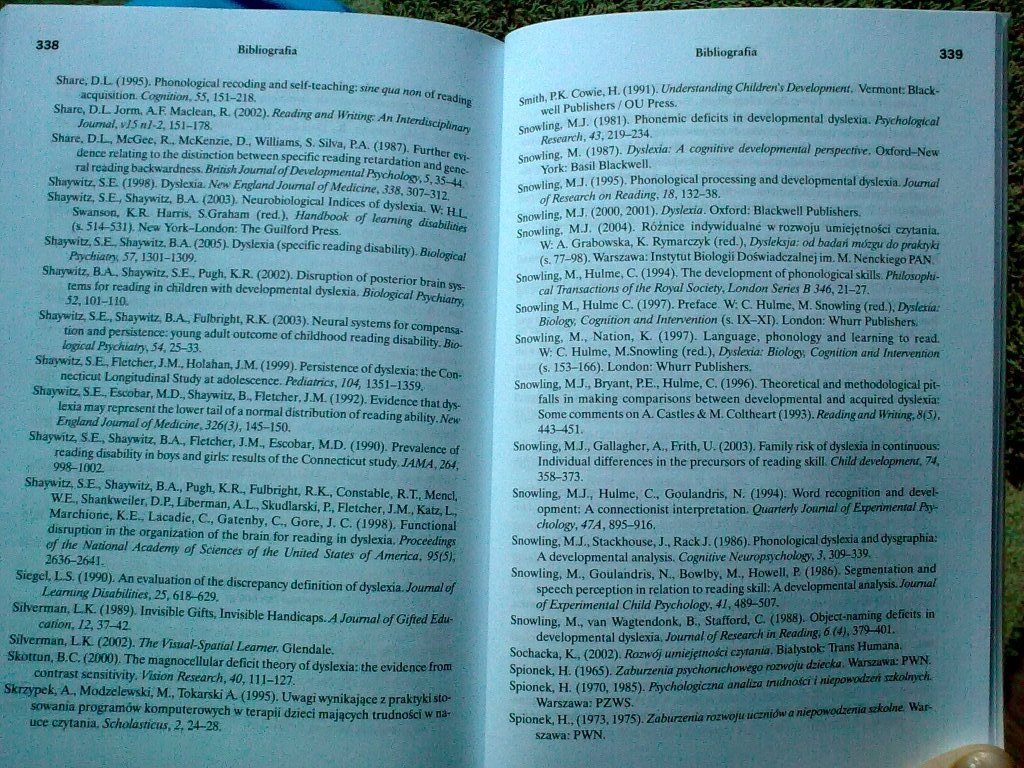Zdjęcie4041

338 Bibliografia
Sharc. DL <1995). Phoootogkml rccoding and aelf-ceaching: smr tjua non of reading acquisi(ion. CagnUHm. 15, 151-218.
Sharc. D-L Jorm. A.E Maclcan. R. <2002). Reading and Wrinng:An fntcrdudpłinary Journal. *15 nJ-2, 151-178.
Sharc. DJ_ McOcr. R, McKcnzie. D-. Williams. S. Słh«,PA (1987). Furthcr evi-deocr re Li ling io ihc diM/ociion bcftcn spccdic reading retardarion and generał reading ttadmrdnctf. Briash Journal ofDcvelopmental Prychology,5.35-44. Shaywicz. SE (1998). Dydciua. Not* Engfand Journal of Medicine. 338.307-312. Shaywicz. S.Ł, Shaywicz. BA (2003). Ncurobiological Indiccs of dyslcxiu. W. Hi. Sauuoo. K.R. Harris. S-Graham (red.). Handbook of leamlng disabilum (t 514-531). New York-Londoo: The Guflford Press.
Shaywicz. S.Ł. Shaywicz. B.A. (2005). Dyslena (spcciTic reading disabilicy). Biological Psychiatry, 57,1301-1309.
Shaywicz, BA. Shaywicz. S.fL, Pugh. K.R. (2002). Olsrupbon of posterior bram sys-Kmi Ipr reading in difldrcn wilb dcvelopmcmal dysforia. Biological Psychiatry,
12, ioj-1 ia
Shaywicz, SIL, Shaywicz. BA Ftifbright, R.K. (2003). Neurai systems for cornpciua-don and pcnutęnce: young aduli ouccome of childbood reading dtsabUity. Bk>-iogrcal Psychiatry, 54, 25-33.
Shaywicz, SM, Flctchcr, J.M. Holahan, J.M. (1999). Persisccnce of dysleria: the Con-neciiaji Longitudirul Siudy ac ndolcscence. Pediatria, 104, 1351-1359.
Shaywicz, S£_ Escobar, MD, Shaywicz. B- Flctchcr. J.M. (1992). Evidcnęe fhat dy*-leri? may represenc che lowcr taił of a norroal distribution of reading ability. New Engfand Journal of Medianę, 326(3), 145-150.
Shaywnz, S.Ł. Shaywicz. BA, Flcfcher. J-M-. Escobar, MD. (1990). PrevaJencc of reading dmabihty m boye and girls; rcsults of che Connecticut srudy, JAMA, 264, 998-1002.
Shaywicz. SE, Shaywicz. BA, Pugh. K.R.. FuJbrighi. RJC_ Constablc. R.T., Menel, WE, Shaiikweiier. D.P, Łibcrman, AL, Skudlarski, P.. Flctchcr, J.M., Kalz. L. Marchione, K.E. Lacadic, C., Gaienby, C., Gore, J. C. (J998). Functionał duruptkut in Che organizaCtnn of che brain for reading in dysleria. Proceedings <rf the National Academy of Sciences of the United States of America, 95(5), 2636-2641,
Sicgcł. L-S. (1990). An cyaluation of che dńcrcpancy definition of dysleria. Joumaiof Leanung Duabilitiet.25,618-629.
SiKcrman LIC. (1989). Iiwisible Gifts, Inrisiblc Handicaps.^4 Journal ofGifted Edu-cation, 12,37-42
Sdverraan. LIC (2002). The Vmtal~Spasiai Leamer, Głecidate.
SŁoteun. B.C (2000). The magnoccliuiar dcfidi theory of dysleria: che cvidencefroni ooncrasr scn»Civily. Hntw Research, 40,111-127.
Skrzypek. A.. Modzelewski, M., Tokarski A. (1995). Uwagi wynikające z prakcyld stosowania programów komputerowych w terapii dzieci mających trudności w nauce czytania. Scholastieus, 2,24-28.
Smith, P.K. Cowie, H. (1991). Undcmanding Childreris IMelopment. Vcrmont: Black-well Publisher*/OU Press.
Snowling. MJ. (1981). Phonęmic dcficits in developmenial dyslexia. Prychologlcal Research, 43.219-234.
Snowling. M. (1987). Dyslała: A cognitire developmental pmpectńt. Otford-Ncw York: Basil Blackwell.
Snowling. M J. (1995). Phonological Processing and dcvelopmcntal dyslctia. Journal of Research on Reading, 18,132-38.
Snowling. MJ. (2000,2001). Dysleda. Orford: Bladcwcll Publishcrs. knowlmg. M J. (2004). Różnice indywidualne w rozwoju umiejętności czytania. W: A. Grabowska, K. Rymarczyk (red.), Dysleksja: od badań mózgu do praktyki (s. 77-98). Warszawa: Instytut Biologii Doświadczalnej im. M. Nenckiego PAN.
Snowling, M., Hulme, C (1994). The devdopmcM of phonological skills. Phitosophi-cal Transaaions of the Royal Society, London Seria B 346,21-27.
Snowling M. Hulme C (1997). Preface W; C. Hulme. M Snowling (red.). DysUńa: Biology, Cognition and Intenenńon (s. 1X-XI). London: Whurr Publisher*.
Snowling, M., Nation, K. (1997). Language, phonology and learnrng to read W C. Hulme, MSnowling (red.), Dysłeńa: Biology, Cognition and Imenmhon (s. 153-166). London: Whurr Publishcrs.
Snowling, M J, Bryam. RE.. Hulme, C. (1996). Theorebcai and metbodotogial prt-falls in making comparisoos between developmental and acquired dyslexia: Some commcnts on A. Castle* & M. Coltheart (1993). Reading and lVriting,8(5). 443-451.
Snowling, MJ., Gallaghcr, A., Frith,U. (2003). Family risk of dysJezia in contmoou*. Indhridual differcnces in the precursors of reading słali. OuUdentoament. 74, 358-373.
Snowling, MJ., Hulme, C., Goulandris, N. (1994). Word rccognłtion and devcl-opmcnt: A connectionist interpretation. Quarierlv Journal of ExperimentaI fty-ckology, 47A, 89S-916.
Snowling, M J.. Stackhousc, J.. Rack J. (1986). Phonołogkal dysłern and dysgrapłńa: A dcvclopraental analysis. Cogmiiw Neuropąchology, 3,309-339.
Snowling, M., Goulandris, N.. Bowlby. M., Howcll, P. (1986). Segmeniation and speech perception in relation to reading skill: A dcvclopmenUl analysis. Journal of Ezperimental Child Psychology; 41,489-507.
Snowling, M., van Wagtcndonk. B., Stufford, C. (1988). Objecr-naming dcffcits in devclopmenial dysforia. Journal of Research ui Reading, 6 (4), 379-401.
Sochacka, IC, (2002). Rozwój umiejętności czytania, Białystok: Sfim Humana.
Spłonek, H; (1965). Zaburzenia psychoruchowego nawoju dziecka. Wuizawa: PWN.
Spłonek, H. (1970,1985)- Psychoiopczna analiza trudności i niepowodzeń szkolnych. Warszawa: PZWS.
Spionek, H .(1973.197S). Zaburzenia rozwoju uanid* o niepowodzenia szkolne W«r-
szawa: PWN.
Wyszukiwarka
Podobne podstrony:
Zdjęcie009 p-S~ -- * - ^ 90d V - % ■ v«-^) dł} sk d*x ^ <U2 " ~3F ?- v» II
Zdjęcie0180 (7) Ii l$™S .wwi, i dl I ■M il pi -: ‘ L li $ B»
Zdj?cie0636 ( > W DUSWIADI ZENIT R( >ZW< »Dl* WPŁYWA NAJBARDZIEJ NE* JATYWNIE? o Konflikt:
Zdjecie941 I lii &L M * -sir V*ri* - i dl- lfc»9mŁ k% *
Zdjęcie 0027 (1) ECZAMMtCMDtnnzrCZNU HCC-Dł irtCJOIIr. ZADANIA Hę i nazwisko studcaU/lH - &nbs
Zdjęcie0251 2 1° M I) 20U Ptnł dl luli liii- I Aliill rr I Nnnyrtt l.ttill Jlt rama i liomlj tarriry
Zdjęcie1031 ^otiokgU Onkologia — podrycawlk dl* itudwlłw 1 lekaray a to.
Zdjęcie4032 320 Bibliografia Bogdanowicz. M. Adryjanck. A (2004). Uczeń z dysleksją w okolę. Poradni
Zdjęcie4034 324 Bibliografia Ellis, N„ Largc, B. (1987). The devdopmcn( of reoding: As you scck so s
Zdjęcie4035 326 Bibliografia Gaywa. J- Soi Ib. S.D„ Cberny, S-S.. Cardon, L-R- Fułker, D.W.. Kjmbert
Zdjęcie4036 328 Bibliografia Hart. R-. Kcm-all. R (2001). Impaircd Processing of rapid stimulus sei
Zdjęcie4037 330 Bibliografia Knvali K.A., Forness, S.R. (2000). Whai dcfinitions of Icaming dHabilii
Zdjęcie4038 332 Bibliografia Lovcgrt>vc, WJ.. Bowling, A . Badcock, D. Blnckwood, M. (1980). Spc
Zdjęcie4039 934 Bibliografia Nation, K., Snowling, MJ. (1998). Individual diffcrences in contcrtual
Zdjęcie4040 336 Bibliografia Pietras, f. (2006). Dysortografia - problemy psychologiczne. Gdańsk: Wy
Zdjęcie4042 340 Bibliografia Sprenger-CharoHo*. L, Cole, R, .Semiclaw, W. (2006). Reading acr/utslrt
Zdjęcie4044 344 Bibliografia Wagner, R.K.. Tbrgesen. JJC . Rashottc. CA.. Hccht !ŁAm Barter, TA, Bur
Zdjęcie4033 322 Bibliografia CostJes. Am Colthcart, M. (1996). Cognitive corrclalcs of dcvclopmcnul
więcej podobnych podstron